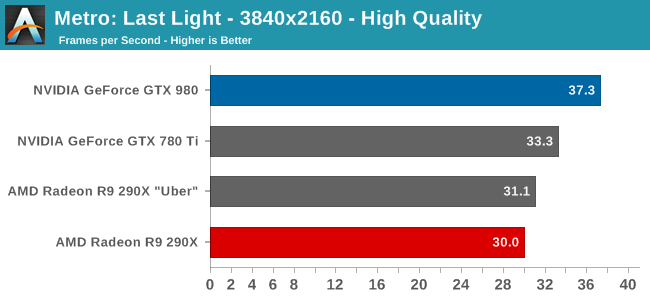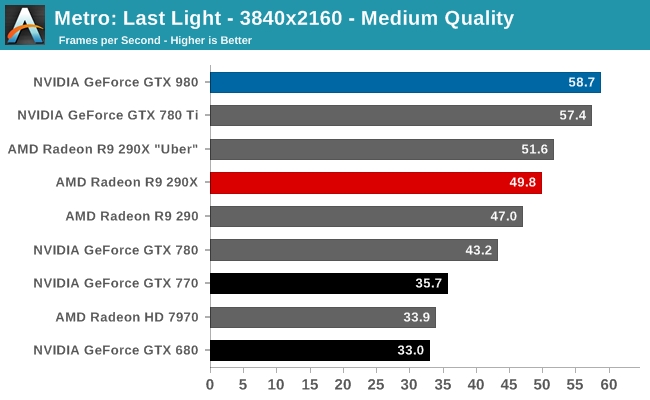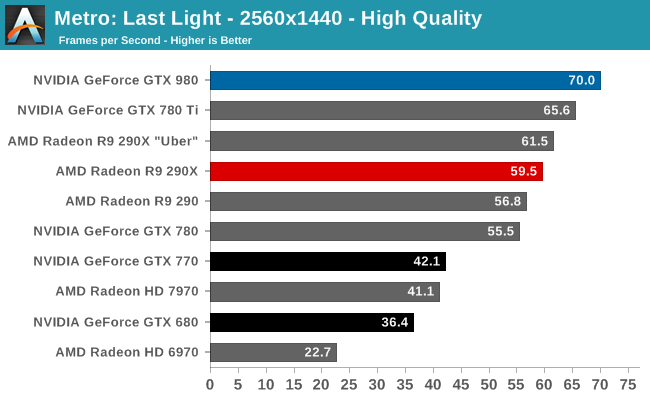The NVIDIA GeForce GTX 980 Review: Maxwell Mark 2
by Ryan Smith on September 18, 2014 10:30 PM ESTMetro: Last Light
As always, kicking off our look at performance is 4A Games’ latest entry in their Metro series of subterranean shooters, Metro: Last Light. The original Metro: 2033 was a graphically punishing game for its time and Metro: Last Light is in its own right too. On the other hand it scales well with resolution and quality settings, so it’s still playable on lower end hardware.




As has become customary for us for the last couple of high-end video card reviews, we’re going to be running all of our 4K video card benchmarks at both high quality and at a lower quality level. In practice not even GTX 980 is going to be fast enough to comfortably play most of these games at 3840x2160 with everything cranked up – that is going to be multi-GPU territory – so for that reason we’re including a lower quality setting to showcase just what performance looks like at settings more realistic for a single GPU.
GTX 980 comes out swinging in our first set of benchmarks. If there was any doubt that it could surpass the likes of R9 290XU and GTX 780 Ti, then this first benchmark is a great place to set those doubts to rest. At all resolutions and quality settings it comes out on top, surpassing NVIDIA’s former consumer flagship by anywhere from a few percent to 12% at 4K with high quality settings. Otherwise against the R9 290XU it’s a consistent 13% lead at 2560 and 4K Medium.
In absolute terms this is enough performance to keep its average framerates well over 60fps at 2560, and even at 3840 Medium it comes just short of crossing the 60fps mark. High quality mode will take the wind out of GTX 980’s sails though, pushing framerates back into the borderline 30fps range.
Looking at NVIDIA’s last-generation parts for a moment, the performance gains over the lower tier GK110 based GTX 780 are around 25-35%. This is about where you’d expect to see a new GTX x80 card given NVIDIA’s quasi-regular 2 year performance upgrade cadence. And when extended out to a full 2 years, the performance advantage over GTX 680 is anywhere between 60% and 92% depending on the resolution we’re looking at. NVIDIA proclaims that GTX 980 will achieve 2x the performance per watt of GTX 680, and since GTX 980 is designed to operate at a lower TDP than GTX 680, as we can see it means performance over GTX 680 won’t quite be doubled in most cases.










274 Comments
View All Comments
Laststop311 - Saturday, September 20, 2014 - link
I'm going to wait for the custom gtx 980's. It was already throttling from reaching the 80C limit on most games. Blower design wouldn't of throttled if they left the vapor chamber in but they didnt. My case has plenty of airflow so i don't require a blower design. MSI twin frozr V open air design will cool the gpu much better and stop it from throttling during gaming. People rushing to buy the reference design are missing out on 100's of mhz due to thermal throttle.chizow - Saturday, September 20, 2014 - link
Yep the open-faced custom coolers are definitely better at OC'ing, especially in single-GPU configs, but the problems I have with them are:1) they tend to have cheaper build quality than the ref, especially the NVTTM cooler which is just classy stuff. The custom coolers replace this with lots and lots of plastic, visible heatpipes, cheapo looking fans. If I wanted an Arctic Accelero on my GPUs I would just buy one.
2) they usually take longer to come to market. Frequently +3-6 weeks lead time. I know its not a super long time in the grand scheme of things, but I'd rather upgrade sooner.
3) The blowers tend to do better in SLI over longer periods of time, and also don't impact your CPU temps/OC as much. I have a ton of airflow too (HAF-X) but I still prefer most of the heat being expelled from the start, and not through my H100i rad.
4) Frankly I'm not too worried about squeezing the last 100-150MHz out of these chips. There was a time I might have been, but I tend to stick it to a safe OC about 100-150MHz below what most people are getting and then call it a day without having to do a dozen 3DMark loops to verify stability.
Laststop311 - Sunday, September 21, 2014 - link
Did you see the benchmarks. Some games were running in the 900's some in the 1000's some in 1100's. Stuck at these frequencies because the card was riding the 80C limit. As the review mentioned these aren't the same titan coolers as they removed the vapor chamber and replaced it with regular heatpipes. Getting a custom cooled card isnt about squeezing the last 100-150 from an OC its about squeezing an extra 400-600 mhz from an OC as many reviewers have gotten the gtx 980 to OC to 1500mhz. We are talking a massive performance increase from getting the proper cooling bigger than even the r9 290x going from reference to custom and that was pretty big itself.Laststop311 - Sunday, September 21, 2014 - link
Even to get the card to reliably run at stock settings during intense gaming you need a custyom cooled card. The reference cooled card can't even reliably hit its stock clock under intense gaming because the blower cooler without vapor chamber sucks.chizow - Sunday, September 21, 2014 - link
No, you can adjust the Nvidia fan and GPU temp settings to get sustained Boosts. There is a trade-off in terms of fan noise and/or operating temps, but it is easy to get close to the results of the custom coolers at the expense of fan noise. I personally set my fan curve differently because I think Nvidia's 80C target temp profile is a little bit too passive in how quickly it ramps up fanspeeds. I don't expect to have any problems at all maintaining rated Boost speed, and if I want to overclock, I fully understand the sacrifice will be more fan noise over the custom coolers, but the rest of the negatives regarding custom coolers makes the reference cooler more appealing to me.venk90 - Thursday, September 18, 2014 - link
The GTX 980 page on NVIDIA website seems to indicate HDMI 1.4 as it says 3840*2160 at 30 Hz over HDMI (it is mentioned as a foot note). Are you sure about it being HDMI 2.0 ?Ryan Smith - Thursday, September 18, 2014 - link
Yes. I've confirmed it in writing and in person.vegitto4 - Thursday, September 18, 2014 - link
Hi Ryan, great review! There will be the usual HTPC perspective? For example, did they fix the 23.976 refresh rate as Haswell does? I think it's important to know how these work as htpc cards. RegardsRyan Smith - Thursday, September 18, 2014 - link
For this article there will not. These cards aren't your traditional HTPC cards. However we can possibly look into it for next week's follow-up.chizow - Friday, September 19, 2014 - link
I think the definition of HTPC is beginning to change though, and while these may not yet fit into traditional HTPC (Brix and NUC seem to be filling this niche more), they are definitely right in the SteamBox/BattleBox category.Honestly, SteamBox was the first thing that came to mind when I saw that 165W TDP on the GTX 980, we will be seeing a lot of GM204 variants in the upcoming years in SFF, LAN, SteamBox and gaming laptop form factors that is for sure.